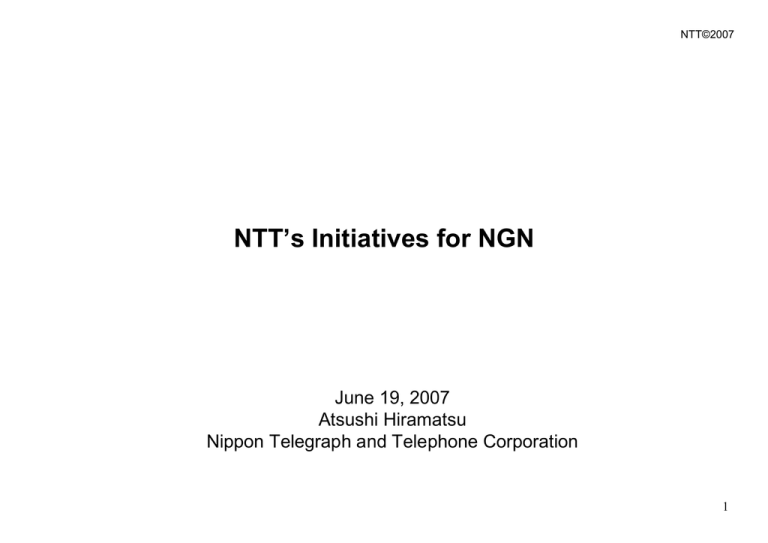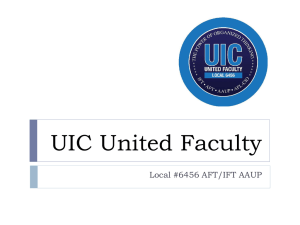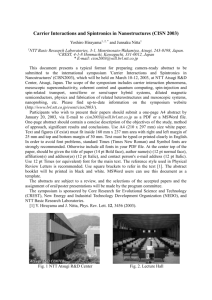NTT’s Initiatives for NGN June 19, 2007 Atsushi Hiramatsu
advertisement

NTT©2007 NTT’s Initiatives for NGN June 19, 2007 Atsushi Hiramatsu Nippon Telegraph and Telephone Corporation 1 NTT©2007 2 NTT©2007 3 NTT©2007 4 NTT©2007 5 NTT©2007 (Released in November 2004) 6 NTT©2007 7 NTT©2007 Roadmap for building the NGN 8 NTT©2007 NTT Otemachi Showroom for NGN field trial 9 NTT©2007 NTT’s technologies for NGN 10 NTT©2007 NGN architecture overview at ITU-T Applications ANI Management functions Application support functions & service support functions Service user prifiles Service control funictions Service stratum Transport user profiles Network attachment control functions End-user functions Resource and admission control functions Other networks Transport control functions Transport control functions UNI NNI Transport stratum Control Media Management 11 NTT©2007 Overview of NGN field trials IP-broadcast server VoD server UNI : User-Network Interface NNI : Network-Network Interface SNI : Application Server-Network Interface Application server SNI NGN IP networks of other companies NGN trial network Interactive Multicast (unicast) communication communication (unidirectional) (unidrectional) Interactive (unicast) communication (bidirectional) PP PoE t nec n o c UNI ion ISPs, etc. NNI Terminals Terminals 12 NTT©2007 Communication functions and service examples in field trails Communication functions Interactive (unicast) communication (bidirectional) Interactive (unicast) communication (unidirectional) Service category Bandwidth (codec) IP telephony (with 0AB-J phone number) Highest priority •Wideband speech: 7kHz (G.722, etc) •Narrowband speech: 3.4kHz (G.711) Video telephony (with 0AB-J phone number) Highest priority •SDTV class (MPEG4): 2 Mb/s •HDTV class (MPEG2): 30 Mb/s Video delivery (VoD / IP broadcast) High priority •SDTV class (MPEG2): 6 Mb/s •HDTV class (H.264): 10 Mb/s Multicast communication (unidirectional) PPPoE connection QoS class Best effort ISP connection Best effort 13 NTT©2007 QoS objectives in NGN field trials Interactive (unicast) Class Highest-priority High-priority Priority Diffserv mapping EF AF(high) AF(low) IP-packet transfer delay 70ms (UNI-UNI) 200ms (UNI-UNI) IP-packet trnasfer delay variation 20ms (UNI-UNI) 200ms (UNI-UNI) IP-packet loss ratio 0.1% (UNI-UNI) 0.1% (UNI-UNI) NOT specified Multicast IP-packet transfer delay 400ms (UNI-SNI) IP-packet transfer delay variation 200ms (UNI-SNI) IP-packet loss ratio 0.1% (UNI-SNI) NOT specified* *Priority-class traffic is given priority over best-effort class by packet transfer processing in the network 14 NTT©2007 Quality in telecommunication services Service quality (in a broad sense) Example: Customer satisfaction (difference between user expectations and customer-service response) Quailty of experience Examples: Articulation in voice, block noise in video Network performance Examples: Delay, loss, frequency of faults in equipment Telecommunication network UNI UNI 15 NTT©2007 QoS regulations for IP telephony using 0AB-J phone numbers QoS objectives between UNI and UNI IP-packet transfer delay: 70 ms max. IP-packet transfer delay variation: 20 ms max. IP-packet loss ratio: 0.1% max. Popular IP telephony terminal UNI UNI Popular telephony terminal Carrier A’s IP network NNI (Interconnection on IP-layer) QoS objectives between UNI and NNI IP-packet transfer delay: 50 ms max. IP-packet transfer delay variation: 10 ms max. IP-packet loss ratio: 0.05% max. Carrier B’s IP network From: Next Generation IP Network Promotion Forum, Japan 16 NTT Research and Development for NGN NTT©2007 Platform/application technologies IP broadcast server Authentication/ ・・・ time-certification VoD server SNI Service control layer Server platform technologies Session control server Various network control servers ・・・ Transport network layer Large-capacity router ROADM Service edge system GE-PON ONU Transport-system technologies ISP Large-capacity router Transmissionsystem technologies Optical access technologies ROADM Service edge system HGW Information appliances Other IPphone network NNI Ethernet edge system Ethernet-system technologies GE-PON ONU UNI IP phone PSTN Gateway systems HGW GE-PON: gigabit Ethernet passive optical network ONU: optical network unit HGW: home gateway PSTN: public switched telephone network 17 NTT©2007 Architecture for NGN service control server APL Middleware Next-generation server applications High-availability middleware Operating system CGL Hardware ATCA Use Usehigh-availability high-availability middleware middleware Use Useof ofCGL CGL (Carrier (CarrierGrade GradeLinux) Linux) Use Useof ofstandard standardhardware hardware platform platform(ATCA) (ATCA) 18 Basic architecture for QoS control Admission control function: The session control server determines the network resources needed and controls service edge systems NTT©2007 Session control server Highest-priority class High-priority class Passes only traffic within permitted bandwidth Priority class Best-effort class Blocks excessive traffic Service edge system Large-capacity core node Large-capacity core node Service edge system Traffic monitoring/control function: Prevents traffic exceeding allocated bandwidth from flowing into the network 19 NTT©2007 Admission control in the NGN New session request HighLink priority class bandwidth (1) Best effort New session request HighLink priority class bandwidth (1) HighLink priority class bandwidth (1) Highpriority class (2) Best effort HighPriority class (2) Best effort Because bandwidth for two high-priority-class sessions is available, the session request is accepted. The quality of the best-effort class may deteriorate when the bandwidth becomes insufficient. Highpriority class (3) The request for a third highpriority-class session is rejected due to insufficient bandwidth. 20 NTT©2007 Home network configuration for field trail monitor users 21 NTT©2007 High-definition video distribution services 22 NTT©2007 IP retransmission service for terrestrial digital broadcasting 23 NTT©2007 Thank you! I hope you will enjoy the visit to our Otemachi showroom on Thursday. Reference: NTT Financial report on November 2006 (www.ntt.co.jp) NTT Technical Review on June 2007 (www.ntt-review.jp) 24

